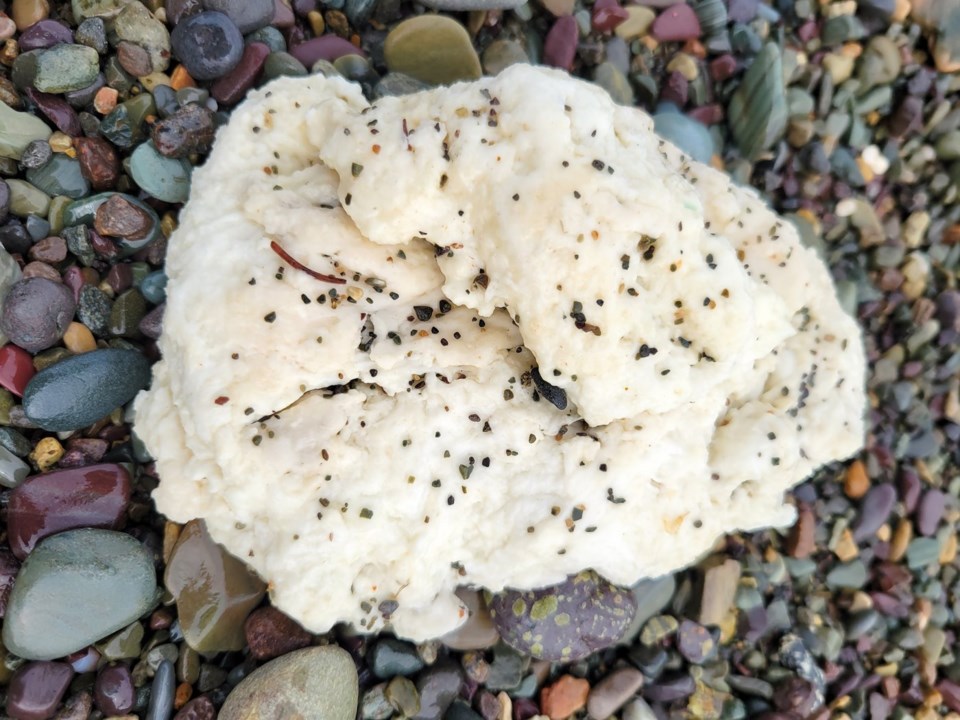ST. JOHN'S, N.L. — A Newfoundland biologist with a specialty in mystery blobs that wash up on the island’s shores is hoping to get his hands on a specimen from the latest gooey arrivals.
Steven Carr, a biology professor at Memorial University in St. John's, N.L., is fascinated by the strange, white globs appearing recently on the shores around Placentia Bay, along Newfoundland’s southern coast.
He said they may be mounds of fat or oil that somehow wound up in the water and were preserved by the North Atlantic’s icy brine — a process he called "adventitious pickling."
“I don't think it's any kind of a vertebrate animal. I don't think it's any kind of plant material. The obvious candidates for an invertebrate, they're simply not there,” he mused in an interview Friday.
“The longer I stare at it, the more it looks like my mother-in-law's really excellent Polish pierogi.”
It’s not clear when the gummy masses first arrived on Newfoundland beaches. Philip Grace first shared a picture of the globules last month in a Facebook group of local beachcombers, asking if anyone knew what they were.
Some were as small as toonies, others as a big as dinner plates, he wrote.
People had many suggestions, some more helpful than others: slime moulds, whale boogers, invertebrates known as sea pork, or toutons, referring to a fried bread dough popular in Newfoundland breakfasts.
One commenter said they'd seen the blobs floating in the water all over the bay.
Officials with the federal Environment Department have been out to investigate and collect samples of the "mystery substance" three times since Sept. 7, said a spokesperson. Neither the substance nor its source has been identified yet, but preliminary tests suggest it may be "plant-based," the department said in an email.
"Additional analysis is required before a final determination can be made on the substance and its potential impacts," the email said.
This is not the first time the North Atlantic has pushed a bizarre substance onto Newfoundland shores. In 2001, a 5.6-metre-long gelatinous, stinking mass was found languishing in the August sunlight on the shores of Fortune Bay. Local residents nicknamed it the "blobster."
Carr was able to use a DNA process to determine it was actually the remnants of a badly decomposed sperm whale.
"I don't think this is a whale. The pieces are not at all similar to what we found," he said Friday. "I'm imagining a crate of something, some sort of food stuff, that fell overboard."
Sea-hardened palm oil has long been washing up on beaches in the United Kingdom, prompting warnings from officials that the white globs are harmful, even fatal, for dogs.
A government website in the northern England district of Wyre notes there have been several "cargo incidents" in recent decades off the coast, "and it is estimated that tonnes of palm oil remains in the wreckages." Ships bringing palm oil to the United Kingdom are also allowed to dump a limited amount of the substance into the sea while cleaning their tanks, the site said.
"Any kind of carbohydrate, any kind of fat, any kind of oil could show up like this," Carr agreed.
He has so far only seen photos of the Placentia Bay blobs, but he has written to federal officials to ask for a sample. Carr hopes his past success in sea blob sleuthing will secure him a specimen.
This report by The Canadian Press was first published Oct. 18, 2024.
Sarah Smellie, The Canadian Press




